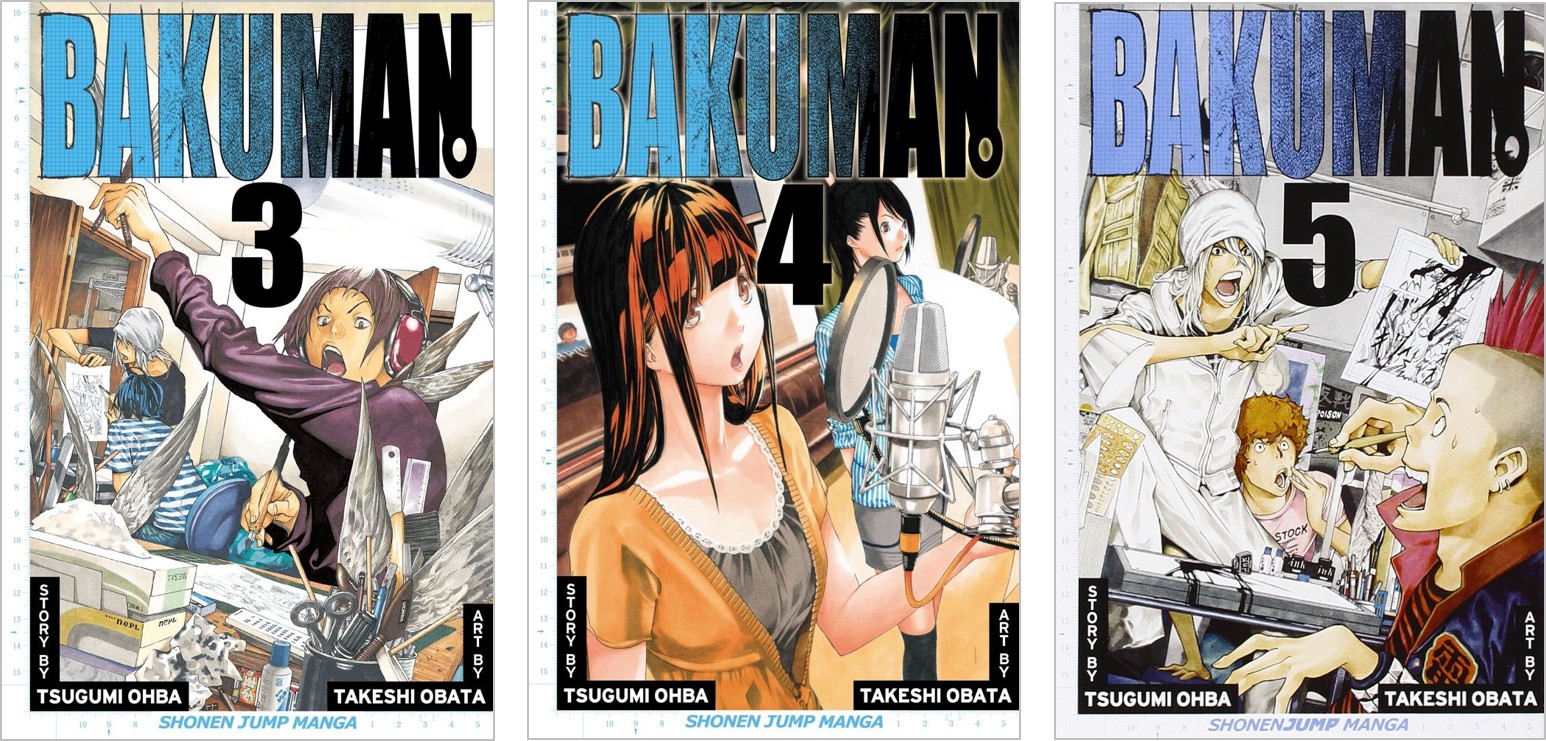25 Mar / Bakuman (vols. 3-5) by Tsugumi Ohba, art by Takeshi Obata, translated by Tetsuichiro Miyaki

Manga-maker wannabes: check out this illuminating insider look (but do start with volumes 1 and 2), then make sure to study every detail if you’re hoping to break into one of the toughest industries around.
But before we talk story, here’s a quick refresher on names: Moritaka Mashiro is the artist (and primary narrator) who also goes by Saikō, an alternative pronunciation of Moritaka (which means “most high”); Akito Takagi is the writer also known as Shūjin (from Takagi, which means “autumn person”) – together, the high schoolers create manga as Muto Ashirogi. Okay, so we’re all clear now who’s who, right?
Volume 3 opens with a third-place win for Muto Ashirogi in manga magazine Akamaru Jump. It’s a good showing, but not good enough to get their own series. While Mashiro and Takagi are in the Shueisha office arguing with their editor Hattori about next steps, boy-genius Eiji Nizuma (who’s showing more and more similarities to “L” in Ohba/Obata’s legendary series, Death Note) arrives in the midst of a mobile yelling match with his editor, and the whole office witnesses his genius in action. Meanwhile, Miho breaks into the voiceover business with her first (small) part, which makes Mashiro want to work even harder so they can be together sooner than later. Takagi finally succumbs to the less-than-subtle charms of schoolmate Miyoshi, which makes Mashiro question Takagi’s commitment to becoming the next great manga team. The pair take the summer break apart: while Takagi works to create a bestselling storyline, Mashiro joins Nizuma’s team in hopes of becoming a better manga-maker. In Nizuma’s studio, he meets fellow assistants Fukuda, another young determined manga artist, and Nakai, a middle-aged manga veteran who’s always an assistant, never the artist (but just wait …!).
The summer separation becomes an actual rift in volume 4 and the dynamic duo part ways! Say it ain’t so! … Okay, it ain’t so (only for a couple of chapters). WHEW! When they realize they’re completely in synch about the next manga project, they’re convinced that Muto Ashirogi is destined for greatness and promise to work harder than ever. Over in voiceover-land, Miho’s up against a skeezy manager who’s demanding she do things she won’t be proud of …
Volume 5 opens with four additions to the Muto Ashirogi studio – three new assistants and Miyoshi who turns out to be rather helpful now that she’s decided that enabling the boys’ success is her dream, too. They’ve also been assigned a new editor, who is not nearly as experienced as Hattori who got them this far. Staying ahead of the competition – many of whom also now happen to be their friends – requires more work than Mashiro and Takagi ever imagined, never mind passing their last year of high school, getting any sleep, and everything else. These teenage manga-makers are living their dream … right …?
Realizing this is shōnen manga (targeted specifically at a young male audience), I know I shouldn’t be surprised that the artist’s angle focuses far too often on Miyoshi’s ample body parts (are comments about the color and pattern of her underwear really necessary??!!). We don’t see Miho as often, but her costumes (for voiceovers?!) sure are noticeably skimpy. Testosterone-titillations aside, how disappointing and annoying that Miyoshi gives up her own dream of becoming a cell phone novelist to ease the boys’ path to success. Which makes me ask, why can’t boys’ manga have more lasting girl power thrown in?
Ever so begrudgingly moving such complaints aside, Bakuman does make for fascinating reading about the challenging, fickle world of manga-making … and ultimately makes us manga addicts that much more appreciative of the tenacity of the artists’ achievements.
Click here to check out all Bakuman volumes on BookDragon.
Readers: Middle Grade, Young Adult
Published: 2011 (United States)
BAKUMAN © Tsugumi Ohba and Takeshi Obata
Original Japanese edition published by Shueisha Inc,

